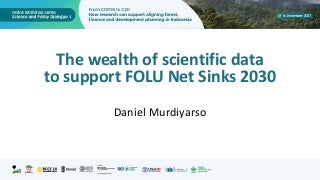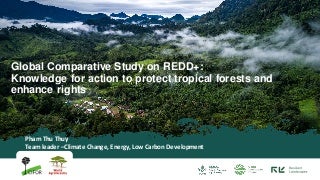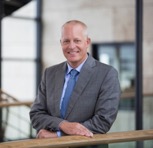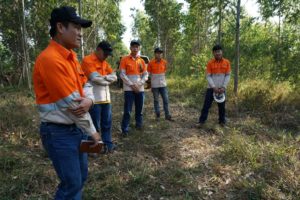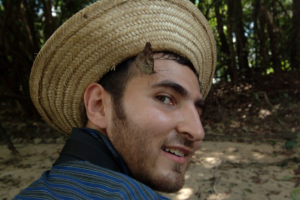
Benjamin Singer of the United Nations Forum on Forests (UNFF) Secretariat shares his views on inclusive landscape finance in the latest of this new interview series.
He brings a decade of experience from his role in implementing the UNFF’s Global Forest Financing Facilitation Network to the discussion. Here he reflects on using public funds to assist developing countries in their efforts to mobilize finance for sustainable forest management.
How do you define ‘inclusive finance’ and why is it important?
There are two distinct ideas to the concept of ‘inclusive finance’ in the context of sustainable forest and land management within the broader landscape. The first relates to the need to mobilize finance as a key ingredient for the implementation of sustainable forms of land and forest management. The second is how to distribute this finance equitably among all stakeholders, with a particular focus on the most vulnerable – local communities, indigenous peoples, women, youth and the elderly.
While much of the debate around sustainable or ‘green’ finance has focused on mobilizing finance, few have considered the equitable distribution of finance once it is mobilized – as if it were a mere side-thought to consider only after money had been secured.
Yet distribution and equitability contribute directly to reducing inequality, one of the root causes of environmental degradation. Wealthier, more powerful stakeholders often exhaust natural resources without having to face the negative externalities they are creating, whereas these tend to fall onto poorer sections of society who rely on these same resources for their livelihoods and even survival.
Empowering this second category of stakeholders, through equitable benefit-sharing, amongst others, would enhance their resilience in the face of environmental change – including climate change.
It could also help create a balance of power that would introduce checks and balances on the use of natural resources by wealthier stakeholders, therefore contributing to reducing environmental degradation in the first place.
Read more: Catalyzing partnerships for reforestation of degraded land
What are the underlying reasons for the underfinancing of small-scale agricultural and forest businesses?
There are trillions of dollars going into investments worldwide – so why is it so difficult to find just a few million to meaningfully reduce the overuse of natural resources? The reason is that the vast majority of these trillions follow well-trodden paths that have shown strong track records of producing returns on investments. Many of these paths are not productive. Some may even be very risky, but they will still be attractive if investors are familiar with them and the mechanisms of investing are straightforward.
In contrast, investing in small-scale agriculture and forestry in developing countries can be daunting to investors from the North – private or institutional. One reason for this is that knowledge of the financial performance within this subsector is scant, if it exists at all.
Such investment also varies considerably from one country to another, and often has a dismal reputation – though mostly unwarranted – of causing environmental degradation. Perhaps most importantly of all, the scale of financing required in each case, which may be one or two million at most – is simply incompatible with opportunities that interest institutional investors, which generally start at half a billion.
What are we not doing right, or not doing well enough, or not doing at all?
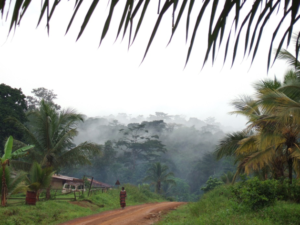
Finance exists (lots of it), and the need for financing exists. One problem is that we are just not connecting the dots. Instead, we are carrying on with business as usual. Investors tend to invest in the usual stock markets that finance the main agricultural commodities produced in developing countries, while foresters in developing countries continue to lament deforestation and forest degradation.
We need to focus on building bridges between sectors (finance, forestry and agriculture), between stakeholders (private investors, public authorities, and small-scale agriculture and forestry businesses) and between concepts (economic development and social and environmental sustainability). All the ingredients are there. The challenge is how to identify, experiment and scale up those win–win solutions that actually work.
Read more: Strengthening producer organizations is key to making finance inclusive and effective
How is your organization addressing inclusive finance, and what are your experiences and key lessons?
The UNFF Secretariat, through its Global Forest Financing Facilitation Network, supports its member states in mobilizing finance for sustainable forest management in three ways:
- Assisting in the design of national forest financing strategies
- Assisting in the design of project proposals to harness funding from multilateral financing institutions such as the Green Climate Fund and the Global Environment Facility
- Creating a clearing house to highlight lessons learnt and best practices in forest financing in developing countries and those with economies in transition
One key lesson is that there is no one-size-fits-all approach. Despite appearing obvious, policy makers time and again underestimate the specificity of financing needs of different countries or different forest stakeholders.
It is essential to get a better understanding of the gaps, obstacles and opportunities related to financing specific forests or forest activities, before targeting financing sources. In some cases, for example, grants from multilateral financing institutions might be the best-adapted source, for others it could be micro-credit from non-governmental organizations.
What examples do you have of successful or promising ‘model’ approaches or innovations?
Policy makers and decision makers often lurch into mobilizing funds from a specific source because they have seen it work in other conditions, or because they have heard that it is easy to access.
However, I consistently recommend developing a forest-financing strategy that takes a step back and helps to understand the financing gaps, obstacles and opportunities. We take a four-step approach to developing such a strategy:
- Identifying and quantifying forest financing needs
- Mapping financing resources according to their origin
- Matching the needs with the sources
- Drawing up a list of tasks required to actually mobilize the shortlisted sources of financing
The idea of developing a forest financing strategy might seem like a cumbersome first step, but we have shown that it can save a lot of time and effort, as it helps identify the most promising sources of financing for the actual needs of the country or stakeholder concerned.
Read more: Background note on FTA financial innovations for sustainable landscapes interviews
What is your vision on how best to increase finance and investment in sustainable forestry and farming?
My vision is simple: partnerships. Again, this might seem obvious, but the financial sector is extremely competitive and this spills over into the world of forest finance. I have often seen supposed partners compete and withhold information and resources from each other, despite sharing the overall goal of sustainable forest management. And I have seen this result in failure for all, time and again.
Forest finance differs fundamentally from the broader finance sector in that the maximization of one’s personal gain as the overarching objective is replaced with a global gain, through the implementation of sustainable forest management worldwide. In this respect, competition is counterproductive as it inhibits the possibility of partnerships, which are crucial to increasing financing for forests.
To mobilize and equitably distribute the financial means necessary for the benefit of all – from local and indigenous communities to institutional investors, multilateral financing mechanisms, national decision makers and small, medium and large enterprises – we need to agree on both the overall goals and how to best achieve them.
However, building such partnerships is by no means a small task. All stakeholders first need to realize that forest financing is not business as usual, and that partnerships are much more productive than competition.
By Nick Pasiecznik, Tropenbos International.
This article was produced by Tropenbos international and the Centre for International Forestry Research (CIFOR) as part of the CGIAR Research Program on Forests, Trees and Agroforestry (FTA). FTA is the world’s largest research for development program to enhance the role of forests, trees and agroforestry in sustainable development and food security and to address climate change. CIFOR leads FTA in partnership with Bioversity International, CATIE, CIRAD, INBAR, ICRAF and TBI. FTA’s work is supported by the CGIAR Trust Fund.





